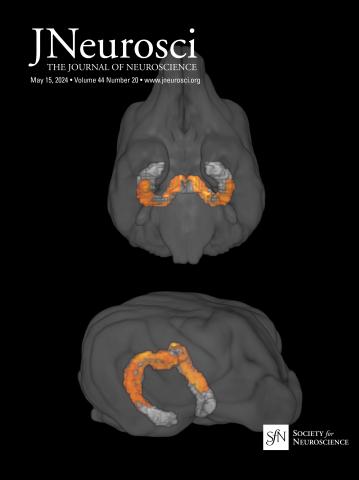多巴胺神经元的调节改变了伏隔核在巴甫洛夫条件反射过程中的行为和事件编码。
IF 4
2区 医学
Q1 NEUROSCIENCES
引用次数: 0
摘要
当线索远离与其相关的奖励时,一些动物将学会接近奖励地点(目标跟踪行为),而另一些动物将接近线索(符号跟踪行为)。手势跟踪的习得,而不是目标跟踪,依赖于伏隔核(NAc)中的多巴胺,我们之前已经证明,NAc核心的奖励诱发活动可能反映了手势跟踪者和目标跟踪者个体多巴胺释放的不同模式。然而,多巴胺释放、NAc活性和手语追踪之间的因果关系尚未确立。利用雄性和雌性TH::Cre大鼠,我们在腹侧被盖区(VTA)多巴胺神经元中表达了抑制性或兴奋性视蛋白,并研究了多巴胺神经元的光学操作对行为和并发NAc神经元活动的影响。我们发现,在获得奖励时,VTA多巴胺神经元的抑制抑制了符号跟踪行为的获得,而不是目标跟踪行为的获得。另一方面,多巴胺神经元的刺激没有改变手势跟踪的习得;然而,停止刺激会阻碍进一步获得手势跟踪。最后,VTA多巴胺神经元的抑制和刺激都能快速调节NAc神经元子集的活动,并导致线索和奖励相关活动的变化。总的来说,这些发现支持了这样的观点,即手势跟踪和目标跟踪是两种不同学习过程的产物——一种依赖多巴胺,另一种不依赖多巴胺——VTA多巴胺对手势跟踪的影响可能是由NAc核心的活动介导的。在巴甫洛夫奖励条件反射过程中,伏隔核(NAc)核心的活动模式似乎反映了符号追踪者(倾向于接近奖励配对线索的个体)和目标追踪者(倾向于接近奖励地点的个体)之间多巴胺释放的差异。在这里,我们使用光遗传学来抑制或刺激学习过程中奖励时的多巴胺神经元。我们发现,抑制抑制了符号跟踪行为的习得,但不抑制目标跟踪行为的习得;同时,刺激没有明显的影响,但停止刺激会抑制进一步的手势跟踪习得,而不会抑制目标跟踪习得。最后,通过记录与光刺激/抑制同时发生的单个神经元,我们表明这些效应可能是由NAc核心的一小部分神经元介导的。本文章由计算机程序翻译,如有差异,请以英文原文为准。
Modulation of dopamine neurons alters behavior and event encoding in the nucleus accumbens during Pavlovian conditioning.
When a cue is located away from its associated reward, some animals will learn to approach the site of reward (goal-tracking behavior) while others will approach the cue (sign-tracking behavior). The acquisition of sign tracking, but not goal tracking, is dependent on dopamine in the nucleus accumbens (NAc), and we have previously demonstrated that reward-evoked activity in the NAc core may reflect different patterns of dopamine release in sign tracker vs. goal tracker individuals. However, a causal relationship among dopamine release, NAc activity, and sign tracking has not been established. Using male and female TH::Cre rats, we expressed inhibitory or excitatory opsins in dopamine neurons of the ventral tegmental area (VTA) and examined the impact of optical manipulation of dopamine neurons on behavior and concurrent NAc neuronal activity. We found that inhibition of VTA dopamine neurons at the time of reward suppressed the acquisition of sign-tracking, but not goal-tracking, behavior. On the other hand, stimulation of dopamine neurons did not alter the acquisition of sign tracking; however, cessation of stimulation impeded further acquisition of sign tracking. Finally, both inhibition and stimulation of VTA dopamine neurons rapidly modulated activity in a subset of NAc neurons and led to changes in cue- and reward-related activity across sessions. Overall, these findings support the ideas that sign tracking and goal tracking are the products of two different learning processes - one dopamine-dependent and one not - and that the impact of VTA dopamine on sign tracking may be mediated by activity in the NAc core.Significance Statement During Pavlovian reward conditioning, activity patterns in the nucleus accumbens (NAc) core appear to reflect differences in dopamine release between sign trackers - individuals who tend to approach reward-paired cues - and goal trackers, who tend to approach the site of reward. Here, we use optogenetics to inhibit or stimulate dopamine neurons at the time of reward during learning. We show that inhibition suppresses the acquisition of sign-tracking behavior but not goal-tracking behavior; meanwhile, stimulation has no overt effect, but cessation of stimulation suppresses further acquisition of sign tracking, but not goal tracking. Finally, by recording from individual neurons concurrent with optical stimulation/inhibition, we show that these effects may be mediated by a small subset of neurons in the NAc core.
求助全文
通过发布文献求助,成功后即可免费获取论文全文。
去求助
来源期刊

Journal of Neuroscience
医学-神经科学
CiteScore
9.30
自引率
3.80%
发文量
1164
审稿时长
12 months
期刊介绍:
JNeurosci (ISSN 0270-6474) is an official journal of the Society for Neuroscience. It is published weekly by the Society, fifty weeks a year, one volume a year. JNeurosci publishes papers on a broad range of topics of general interest to those working on the nervous system. Authors now have an Open Choice option for their published articles
 求助内容:
求助内容: 应助结果提醒方式:
应助结果提醒方式:


